Sun Joe HJ22HTE Handleiding
Sun Joe
Heggenschaar
HJ22HTE
Bekijk gratis de handleiding van Sun Joe HJ22HTE (12 pagina’s), behorend tot de categorie Heggenschaar. Deze gids werd als nuttig beoordeeld door 70 mensen en kreeg gemiddeld 5.0 sterren uit 35.5 reviews. Heb je een vraag over Sun Joe HJ22HTE of wil je andere gebruikers van dit product iets vragen? Stel een vraag
Pagina 1/12

© 2019 by Snow Joe
®, LLC
All rights reserved. Original instructions. SAVE THESE INSTRUCTIONS
1
A Division of Snow Joe
® , LLC Model HJ22HTE Form No. SJ-HJ22HTE-880E-MR6
R
OPERATOR’S MANUAL
ELECTRIC HEDGE TRIMMER
22-INCH | 3.5 AMP
IMPORTANT!
Safety Instructions
All Operators Must Read These
Instructions Before Use
Always follow these safety guidelines. Failure to do so may
result in serious bodily injury or death.
General Power Tool Safety
Warnings
m WARNING Read all safety warnings and all
instructions. Failure to follow the warnings and instructions
may result in electric shock, re and/or serious injury.
Save all warnings and instructions for future reference.
The term "power tool" in the warnings refers to your mains-
operated (corded) power tool or battery-operated (cordless)
power tool.
mDANGER! This indicates a hazardous situation, which,
if not followed, will result in serious injury or death.
mWARNING! This indicates a hazardous situation, which,
if not followed, could result in serious injury or death.
mCAUTION! This indicates a hazardous situation, which,
if not followed, could result in minor or moderate injury.
Work Area Safety
1. Keep work area clean and well lit. Cluttered or dark
areas invite accidents.
2. Do not operate power tools in explosive atmospheres,
such as in the presence of ammable liquids, gases or
dust. Power tools create sparks which may ignite the dust
or fumes.
3. Keep children and bystanders away while operating a
power tool. Distractions can cause you to lose control.
Electrical Safety
1. Power tool plugs must match the outlet. Never modify
the plug in any way. Do not use any adapter plugs with
earthed (grounded) power tools. Unmodied plugs and
matching outlets will reduce risk of electric shock.
2. Avoid body contact with earthed or grounded
surfaces, such as pipes, radiators, ranges and
refrigerators. There is an increased risk of electric shock
if your body is earthed or grounded.
3. Do not expose power tools to rain or wet conditions.
Water entering a power tool will increase the risk of
electric shock.
4. Do not abuse the cord. Never use the cord for
carrying, pulling or unplugging the power tool. Keep
cord away from heat, oil, sharp edges or moving parts.
Damaged or entangled cords increase the risk of electric
shock.
5. When operating a power tool outdoors, use an
extension cord suitable for outdoor use. Use of a cord
suitable for outdoor use reduces the risk of electric shock.
6. If operating a power tool in a damp location is
unavoidable, use a residual current device (RCD)
protected supply. Use of an RCD reduces the risk of
electric shock.
Personal Safety
1. Stay alert, watch what you are doing and use common
sense when operating a power tool. Do not use a
power tool while you are tired or under the inuence
of drugs, alcohol or medication. A moment of inattention
while operating power tools may result in serious personal
injury.
2. Always wear eye protection. Use safety equipment.
Protective equipment such as dust mask, non-skid safety
shoes, hard hat, or hearing protection used for appropriate
conditions will reduce personal injuries.
3. Prevent unintentional starting. Ensure the switch is in
the o-position before connecting to power source and/
or battery pack, picking up or carrying the tool. Carrying
power tools with your nger on the switch or energising
power tools that have the switch on invites accidents.
4. Remove any adjusting key or wrench before
turning the power tool on. A wrench or a key left
attached to a rotating part of the power tool may result
in personal injury.
5. Do not overreach. Keep proper footing and balance at
all times. This enables better control of the power tool in
unexpected situations.
6. Dress properly. Do not wear loose clothing or jewelry.
Keep your hair, clothing and gloves away from moving
parts. Loose clothes, jewelry or long hair can be caught in
moving parts.

2
7. If devices are provided for the connection of dust
extraction and collection facilities, ensure these are
connected and properly used. Use of dust collection can
reduce dust-related hazards.
Power Tool Use + Care
1. Do not force the power tool. Use the correct power
tool for your application. The correct power tool will
do the job better and safer at the rate for which it was
designed.
2. Do not use the power tool if the switch does not turn it
on and o. Any power tool that cannot be controlled with
the switch is dangerous and must be repaired.
3. Disconnect the plug from the power source and/or the
battery pack from the power tool before making any
adjustments, changing accessories, or storing power
tools. Such preventive safety measures reduce the risk of
starting the powertool accidentally.
4. Store idle power tools out of the reach of children and
do not allow persons unfamiliar with the power tool
or these instructions to operate the power tool. Power
tools are dangerous in the hands of untrained users.
5. Maintain power tools. Check for misalignment or
binding of moving parts, breakage of parts and any
other condition that may aect the power tool’s
operation. If damaged, have the power tool repaired
before use. Many accidents are caused by poorly
maintained power tools.
6. Keep cutting tools sharp and clean. Properly maintained
cutting tools with sharp cutting edges are less likely to
bind and are easier to control.
7. Use the power tool, accessories and tool bits etc.,
in accordance with these instructions and in the
manner intended for the particular type of power
tool, taking into account the working conditions and
the work to be performed. Use of the power tool for
operations dierent from those intended could result in a
hazardous situation.
Service
Have your power tool serviced by a qualied repair person
using only identical replacement parts. This will ensure that
the safety of the power tool is maintained.
Hedge Trimmer Safety Warnings
1. Keep all parts of the body away from the cutter blade. Do
not remove cut material or hold material to be cut when
blades are moving. Make sure the switch is o when
clearing jammed material. A moment of inattention while
operating the hedge trimmer may result in serious personal
injury.
2. Carry the hedge trimmer by the handle with the cutter
blade stopped. Blades coast after turn o. Proper
handling of the hedge trimmer will reduce possible personal
injury from the cutter blades.
mDANGER! Keep hands away from blade. Contact with
blade will result in serious personal injury.
3. Use both hands when operating the hedge trimmer.
Using one hand could cause loss of control and result in
serious personal injury.
4. Hold the power tool by insulated gripping surfaces
only, because the cutter blade may contact hidden
wiring or its own cord. Cutter blades contacting a "live"
wire may make exposed metal parts of the power tool
"live" and could give the operator an electric shock.
5. Keep cable away from cutting area. During operation
the cable may be hidden in shrubs and can be
accidentally cut by the blade.
6. Inspect the area to be cut and remove any foreign
objects that will inuence your cutting. If the foreign
objects can not be removed, e.g. wire fences, please mark
and remember it to avoid toughing them during cutting.
7. Hold the hedge trimmer properly with both hands.
Additional Safety Rules for
Hedge Trimmer
1. Recommendation for the use of a residual current device
with a tripping current of 30 mA or less
2. Instructions for proper assembly of the handle and/or
guard if the hedge trimmer is shipped without the handle
or guard in place. In addition, the following warning
statement shall be included in the instructions:
mWARNING! Only use with handle and guard properly
assembled to hedge trimmer. The use of the hedge
trimmer without the proper guard or handle provided may
result in serious personal injury.
3. If devices or facilities are available for the extraction and
collection of dust, ensure these are connected or properly
used. Use of these devices can reduce dust related
hazards.
4. Remove any blade that has been damaged. Always make
sure that the blade is installed correctly and securely
fastened before each use. Failure to do so can cause
serious injury.
5. Never cut any material over 0.63 in. (16 mm) in diameter.
6. Do not use the safety guard or clipping deector as a
gripping surface.
7. Service on the product must be performed by qualied
repair personnel only. Service or maintenance performed
by unqualied personnel could result in injury to the user
or damage to the product.
8. If the power supply cord is damaged, it must be replaced
only by the manufacturer or by an authorized service
center to avoid risk.
9. Do not use the hedge trimmer if the switch does not turn it
on and o. Any power tool that cannot be controlled with
the switch is dangerous and must be repaired.
10. Use the hedge trimmer and accessories in accordance
with these instructions, taking into account the working

3
conditions the work to be performed. Use of the power
tool for operations dierent from intended use could lead
to a hazardous situation.
Electric Safety
1. Ground fault circuit interrupter (GFCI) protection should
be provided on the circuit(s) or outlet(s) to be used for
this electric hedge trimmer. Receptacles are available
having built-in GFCI protection and may be used for this
measure of safety.
2. To reduce the risk of electric shock, this appliance has
a polarized plug (i.e. one blade is wider than the other).
Use this appliance only with a polarized UL-, CSA-, or
ETL-listed extension cord recommended for outdoor,
all-weather use.
The appliance plug will t into a polarized extension
cord only one way. If the appliance plug does not t
fully into the extension cord, reverse the plug. If the plug
still does not t, obtain a correct polarized extension
cord. A polarized extension cord will require the use of a
polarized wall outlet. The extension cord plug will t into
the polarized wall outlet only one way. If the plug does
not t fully into the wall outlet, reverse the plug. If the plug
still does not t, contact a qualied electrician to install
the proper wall outlet. Do not modify the appliance plug,
extension cord receptacle, or extension cord plug in any
way.
3. To prevent electric shock, use only with an extension cord
suitable for outdoor use, such as SW-A, SOW-A, STW-A,
STOW-A, SJW-A, SJOW-A, SJTW-A, or SJTOW-A.
Before use, check that the extension cord is in good
condition. When using an extension cord, make sure to
use one heavy enough to carry the current product. An
undersized cord will cause a drop in line voltage resulting
in loss of power and overheating.
4. To prevent the appliance cord from disconnecting from
the extension cord during operation, use the onboard
extension cord restraint hook and/or make a knot with the
two cords as shown in Table 1.
5. Power tool plugs must match the outlet. Never modify
the plug in any way. Do not use any adapter plugs with
earthed (grounded) power tools. Unmodied plugs and
matching outlets will reduce risk of electric shock.
6. Avoid body contact with earthed or grounded surfaces,
such as pipes, radiators, ranges and refrigerators. There is
an increased risk of electric shock if your body is earthed
or grounded.
7. If the supply cord is damaged, it must be replaced by an
electrician or a power tool repairer.
8. When operating a power tool outdoors, use an extension
cord suitable for outdoor use. Use of a cord suitable for
outdoor use reduces the risk of electric shock.
9. If operating a power tool in a damp location is
unavoidable, use a residual current device (RCD)
protected supply. Use of an RCD with a tripping current of
30 mA or less reduces the risk of electric shock.
10. Have your tool repaired by an electrician or a qualied
service center. This power tool complies with relevant
safety requirements. To avoid danger, electrical appliances
must only be repaired by qualied personnel using original
spare parts; otherwise this may result in considerable
damage to the user.
m WARNING m
Electric shock may cause SEVERE INJURY or
DEATH. Heed these warnings:
• Do not allow any part of the hedge trimmer to make
contact with water while it is in operation. If the
appliance becomes wet while turned o, wipe dry
before starting.
• Use only a UL-, CSA- or ETL-rated extension cord for
outdoor, all-weather use.
• Do not use an extension cord over 100 ft (30 m).
• Do not touch the appliance or its plug with wet hands
or while standing in water. Wearing rubber boots
oers some protection.
EXTENSION CORD CHART
Extension Cord
Length
Wire Gauge (A.W.G.):
Up to 50 ft
(15 m)
+50 ft - 100 ft
(+15 m - 30 m)
16 14
(B) Connect plug and receptacle
Cord set Appliance cord
(A) Tie cord as shown
Table 1. Method of Securing Extension Cord
Product specificaties
| Merk: | Sun Joe |
| Categorie: | Heggenschaar |
| Model: | HJ22HTE |
Heb je hulp nodig?
Als je hulp nodig hebt met Sun Joe HJ22HTE stel dan hieronder een vraag en andere gebruikers zullen je antwoorden
Handleiding Heggenschaar Sun Joe

13 November 2024

13 November 2024

13 Juni 2023

5 Juni 2023

26 Mei 2023

13 Mei 2023

4 Mei 2023

3 Mei 2023

23 April 2023

21 April 2023
Handleiding Heggenschaar
- Hitachi
- Ergotools Pattfield
- Powerplus
- Maxbear
- Garden Feelings
- Greenworks
- Efco
- Hanseatic
- Cotech
- NEO Tools
- Al-ko
- Bavaria
- Milwaukee
- Craftsman
- G-Technology
Nieuwste handleidingen voor Heggenschaar
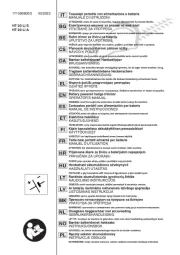
4 September 2025
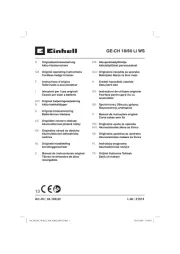
3 September 2025
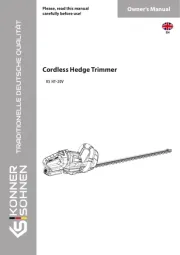
1 September 2025
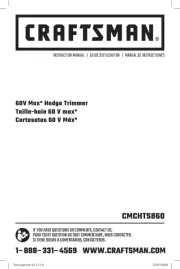
1 September 2025
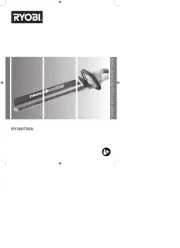
1 September 2025
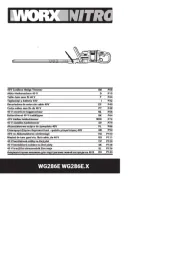
1 September 2025
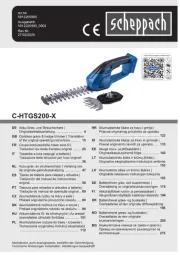
25 Augustus 2025
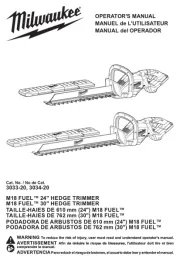
18 Augustus 2025
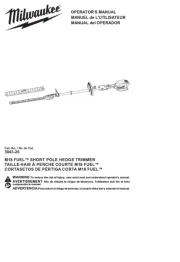
18 Augustus 2025
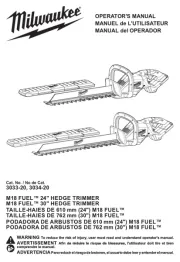
18 Augustus 2025